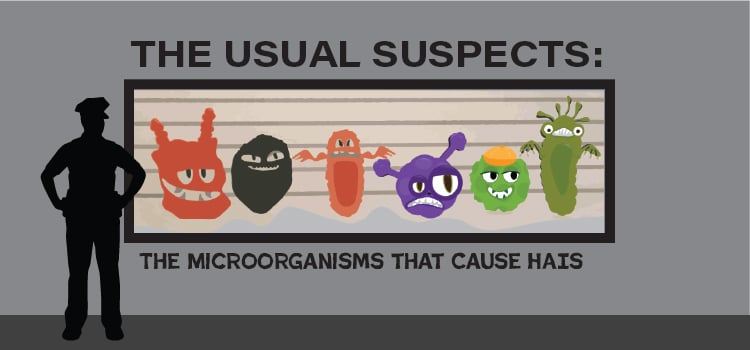C. Diff: The Perfect Storm

You are a patient in the hospital, recovering from a surgical procedure. You are put on antibiotics to prevent infection, and everything seems fine. That is, until you begin to get sick. Not from your surgery, but from abdominal pain, fever, cramping, and terrible diarrhea. Your doctor informs you that you have become infected with Clostridioides difficile. Now you are not only trying to recover from your surgery, you are also trying to fight off the leading cause of hospital-acquired infection death. How did this happen? What is C. diff doing to your body? Today we’ll explore the disease that has hospitals and long-term care facilities desperate to find solutions: Clostridioides difficile colitis.
Clostridioides difficile is the leading cause of antibiotic-related diarrhea, and the leading cause of fatal hospital-acquired infections, resulting in 15,000 deaths directly attributed to C. diff per year (29,000 total within 30 days of a diagnosis). The disease caused by this bacteria results from a “perfect storm” scenario of three conditions: 1) severely reduced gut microflora due to use of antibiotics 2) ingestion of C. diff spores and 3) compromised immune system.
#1 Severely Reduced Microflora
When you take antibiotics, the medicine sets about killing bacteria in your body. Depending on the type of antibiotic, they either attack bacteria cell walls, DNA-making machinery, or DNA-copying machinery. Unfortunately, antibiotics don’t distinguish between the bacteria making you sick and the beneficial bacteria living in your gut. As a result, you experience a significant reduction in what is called commensal bacteria, microorganisms that do you no harm, and in fact, help you by keeping pathogens at bay.
How does commensal bacteria help fight pathogens? Simply by existing and consuming nutrients. They use up most, if not all, of the available nutrients, so any invading pathogens have no source of energy. Your commensal bacteria are also highly specialized, able to physically block space for pathogens to attach or colonize. Should pathogens manage to stick around and start reproducing, the surrounding bacteria will still have an enormous advantage and will eventually deprive the pathogen of space or nutrients.
#2 Ingestion of C. diff Spores
Unfortunately, antibiotics reduce the number of commensal bacteria to such a degree that the invading pathogen has plenty of nutrients for growth and reproduction. If a person on (or recently on) antibiotics ingests a C. diff spore, that pathogen will encounter a very welcoming environment. (Patients taking antibiotics are 7x more likely to suffer a C. diff infection, also called CDI.)
How does a person ingest a C. diff spore? This pathogen is transmitted via the fecal-oral route, which is just as nasty as it sounds. In the middle of this route are contaminated surfaces, where spores can survive for years, and contaminated hands, where they are transferred if hands are not washed.
Once ingested, the spore can easily survive stomach acid, so it soon makes its way to the upper intestine. There the spore can adhere to the lining, where bile acids trigger the necessary signal to the spore to begin germinating. The spore rehydrates and releases a vegetative cell that can begin splitting and reproducing right away.
![]()
The lifecycle of Clostridioides difficile
Opportunistic bacteria such as Clostridioides difficile can set up shop and begin to reproduce, taking over the gut without any competition. In more severe cases, the pathogen toxins result in a pseudomembrane, a thin layer of damaged cells that further protects the pathogen from antibodies sent to destroy it by the immune system.
Clostridioides difficile colitis in an otherwise healthy person can be treated by antibiotics. The medications along with a healthy immune system can return the patient to health, albeit with a 20% risk of recurrence. In those with a compromised immune system, the outcome is not as positive.
#3 Compromised Immune System
Your immune system is a magnificent army that stands ready to defend you from invaders. It’s there filtering germs from your body, sending out white bloods cells if you have an infection, raising your temperature to help kill pathogens, and even keeping a record of the pathogens you’ve encountered in order to kill them faster the next time they invade.
Not everyone’s immune system operates at 100%, however. Newborn infants, for example, have an underdeveloped immune system that doesn’t have the “library” of antibodies at their disposal to fight off infection. Elderly individuals also have a weakened immune system due to aging, making them less capable of fighting infection. Those with chronic medical conditions such as cancer, or who have recently had a significant surgical procedure, are also immunocompromised, as their immune systems are already taxed with their current condition. A virulent, resistant pathogen like C. diff combined with a weak immune system means a severe infection and a much higher risk of a tragic outcome.
How much of a risk? Consider these statistics: 1 out of 11 people 65 or older who contract C. diff colitis will die within one month of diagnosis. More than 80% of the deaths (>11,000 deaths) associated with C. diff colitis were 65 or older.
Looking Towards Solutions
We’ve learned in this post how the “perfect storm” can lead to a case of CDI. The search for solutions cannot just be focused on a small niche of patients, however. Not just those who are hospitalized are at risk: 75% of cases had symptoms that started at a nursing home, outpatient surgery center, or routine doctor’s office. Of the remaining 25%, those cases that started in a hospital, over half of the patients had recently been transferred from another facility. This means that the problem is not localized in hospitals, and no one is without risk.
Next week's post will put this all together by identifying the places where the infection cycle can be broken.
Editor's Note: This post was originally published in April 2016 and has been updated for freshness, accuracy and comprehensiveness.
![EOScu Logo - Dark - Outlined [07182023]-01](https://blog.eoscu.com/hubfs/Eoscu_June2024/Images/EOScu%20Logo%20-%20Dark%20-%20Outlined%20%5B07182023%5D-01.svg)

![[infographic] Stopping the C. diff Cycle Download and share!](https://no-cache.hubspot.com/cta/default/216314/interactive-178280319550.png)



